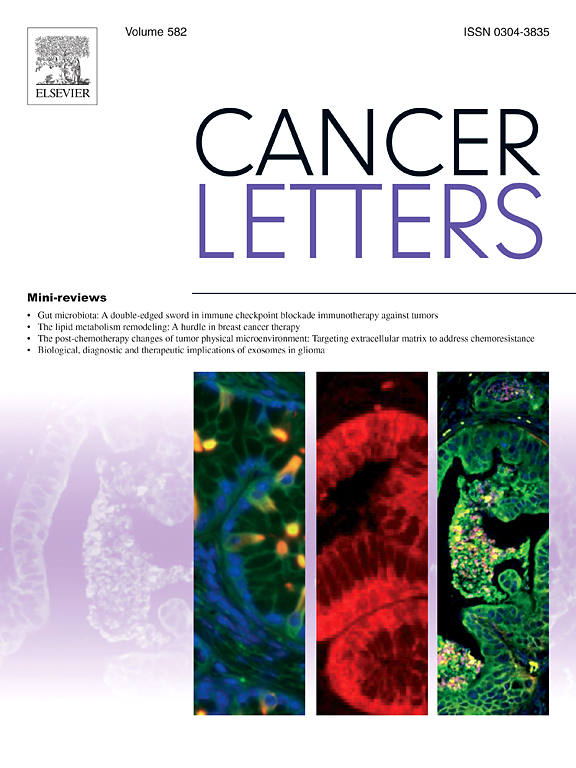SLC7A5/E2F1/PTBP1/PKM2 axis mediates progression and therapy effect of triple-negative breast cancer through the crosstalk of amino acid metabolism and glycolysis pathway
IF 9.1
1区 医学
Q1 ONCOLOGY
引用次数: 0
Abstract
Triple-negative breast cancer (TNBC) is one of the most challenging malignancies with the highest mortality rates among women. TNBC relies on both amino acid metabolism and glycolysis to fuel its bioenergetic and biosynthetic demands. However, the potential crosstalk between these two metabolic pathways and its impact on TNBC progression remain largely unexplored. In this study, we observed that SLC7A5, a key amino acid transporter, was upregulated in TNBC and strongly associated with poor patient prognosis. We demonstrated that the elevated SLC7A5 expression activated the amino acid pathway and promoted cell proliferation, tumor growth, and therapeutic resistance by inducing the switch from PKM1 to PKM2 expression, thereby mediating the crosstalk between amino acid metabolism and glycolysis. We further identified that the upregulation of SLC7A5 resulted from miR-152 suppression, which regulates TNBC cellular function and tumor growth. In addition, the miR-152/SLC7A5 axis mediated the expression of PTBP1, which maintains the balance between PKM1 and PKM2, linking amino acid signaling with the glycolysis pathway. To further understand the mechanism of PTBP1 upregulation, we identified that E2F1 transcriptionally activated PTBP1 expression through direct binding at the seed site, while E2F1 expression was also induced by SLC7A5 in TNBC. This novel SLC7A5/E2F1/PTBP1 axis plays a crucial role in regulating the crosstalk between amino acid signaling and glycolysis in TNBC and is essential for TNBC progression and therapeutic effectiveness. Our findings offer valuable insights into the molecular mechanisms underlying TNBC metabolic reprogramming and highlight potential targets for future therapeutic interventions.
SLC7A5/E2F1/PTBP1/PKM2轴通过氨基酸代谢和糖酵解途径的串扰介导三阴性乳腺癌的进展和治疗效果。
三阴性乳腺癌(TNBC)是妇女死亡率最高的最具挑战性的恶性肿瘤之一。TNBC依靠氨基酸代谢和糖酵解来满足其生物能量和生物合成需求。然而,这两种代谢途径之间的潜在串扰及其对TNBC进展的影响在很大程度上仍未被探索。在本研究中,我们发现关键氨基酸转运蛋白SLC7A5在TNBC中表达上调,并与患者预后不良密切相关。我们证明,SLC7A5表达升高激活氨基酸通路,通过诱导PKM1到PKM2表达的转换,从而介导氨基酸代谢和糖酵解之间的串扰,促进细胞增殖、肿瘤生长和治疗抗性。我们进一步发现SLC7A5的上调是由miR-152抑制引起的,miR-152调节TNBC细胞功能和肿瘤生长。此外,miR-152/SLC7A5轴介导PTBP1的表达,维持PKM1和PKM2之间的平衡,将氨基酸信号通路与糖酵解途径联系起来。为了进一步了解PTBP1上调的机制,我们发现E2F1通过直接结合种子位点转录激活PTBP1的表达,而在TNBC中,SLC7A5也会诱导E2F1的表达。这种新的SLC7A5/ E2F1/PTBP1轴在TNBC中调节氨基酸信号和糖酵解之间的串扰起着至关重要的作用,对TNBC的进展和治疗效果至关重要。我们的发现为TNBC代谢重编程的分子机制提供了有价值的见解,并强调了未来治疗干预的潜在目标。
本文章由计算机程序翻译,如有差异,请以英文原文为准。
求助全文
约1分钟内获得全文
求助全文
来源期刊

Cancer letters
医学-肿瘤学
CiteScore
17.70
自引率
2.10%
发文量
427
审稿时长
15 days
期刊介绍:
Cancer Letters is a reputable international journal that serves as a platform for significant and original contributions in cancer research. The journal welcomes both full-length articles and Mini Reviews in the wide-ranging field of basic and translational oncology. Furthermore, it frequently presents Special Issues that shed light on current and topical areas in cancer research.
Cancer Letters is highly interested in various fundamental aspects that can cater to a diverse readership. These areas include the molecular genetics and cell biology of cancer, radiation biology, molecular pathology, hormones and cancer, viral oncology, metastasis, and chemoprevention. The journal actively focuses on experimental therapeutics, particularly the advancement of targeted therapies for personalized cancer medicine, such as metronomic chemotherapy.
By publishing groundbreaking research and promoting advancements in cancer treatments, Cancer Letters aims to actively contribute to the fight against cancer and the improvement of patient outcomes.
 求助内容:
求助内容: 应助结果提醒方式:
应助结果提醒方式:


